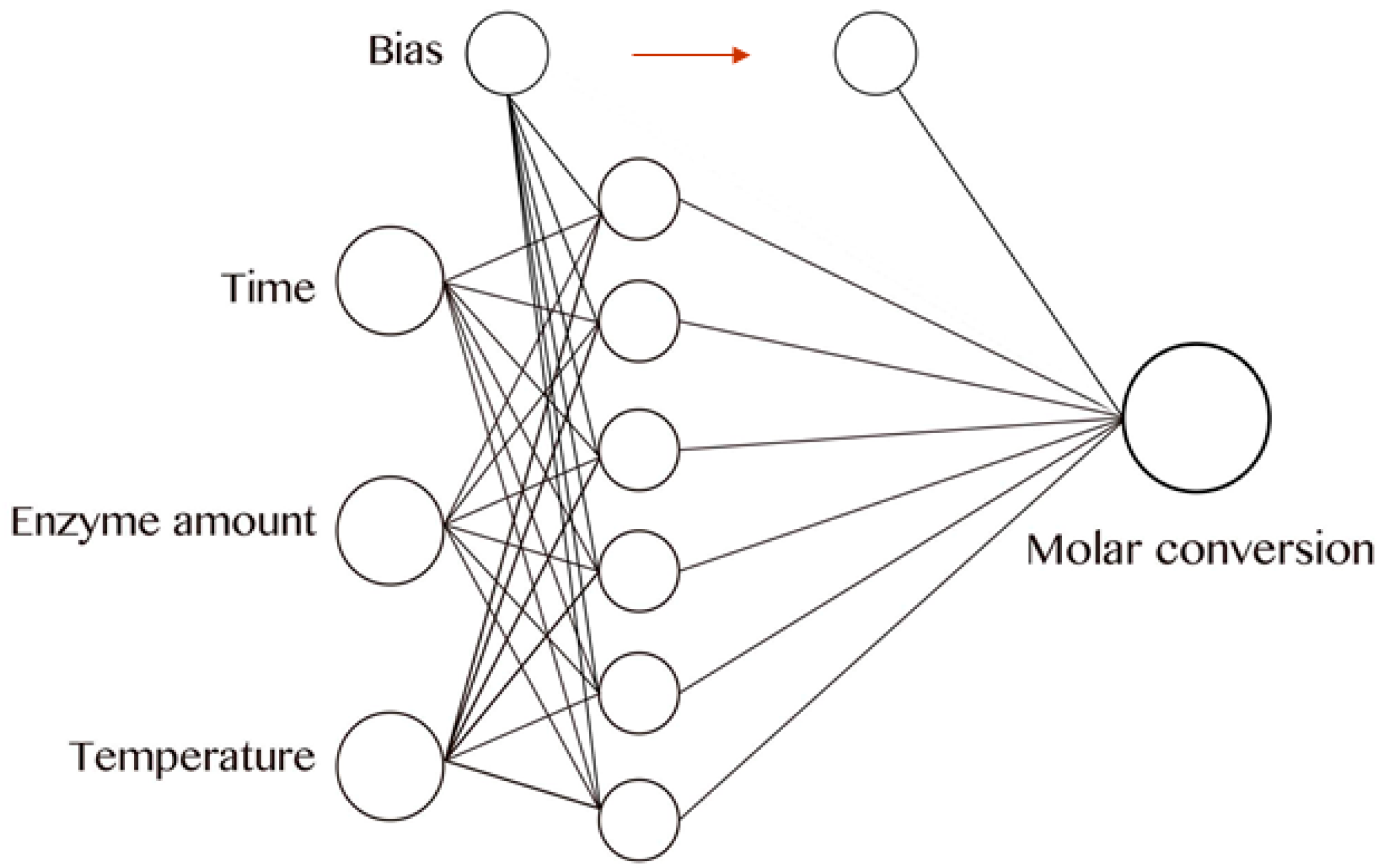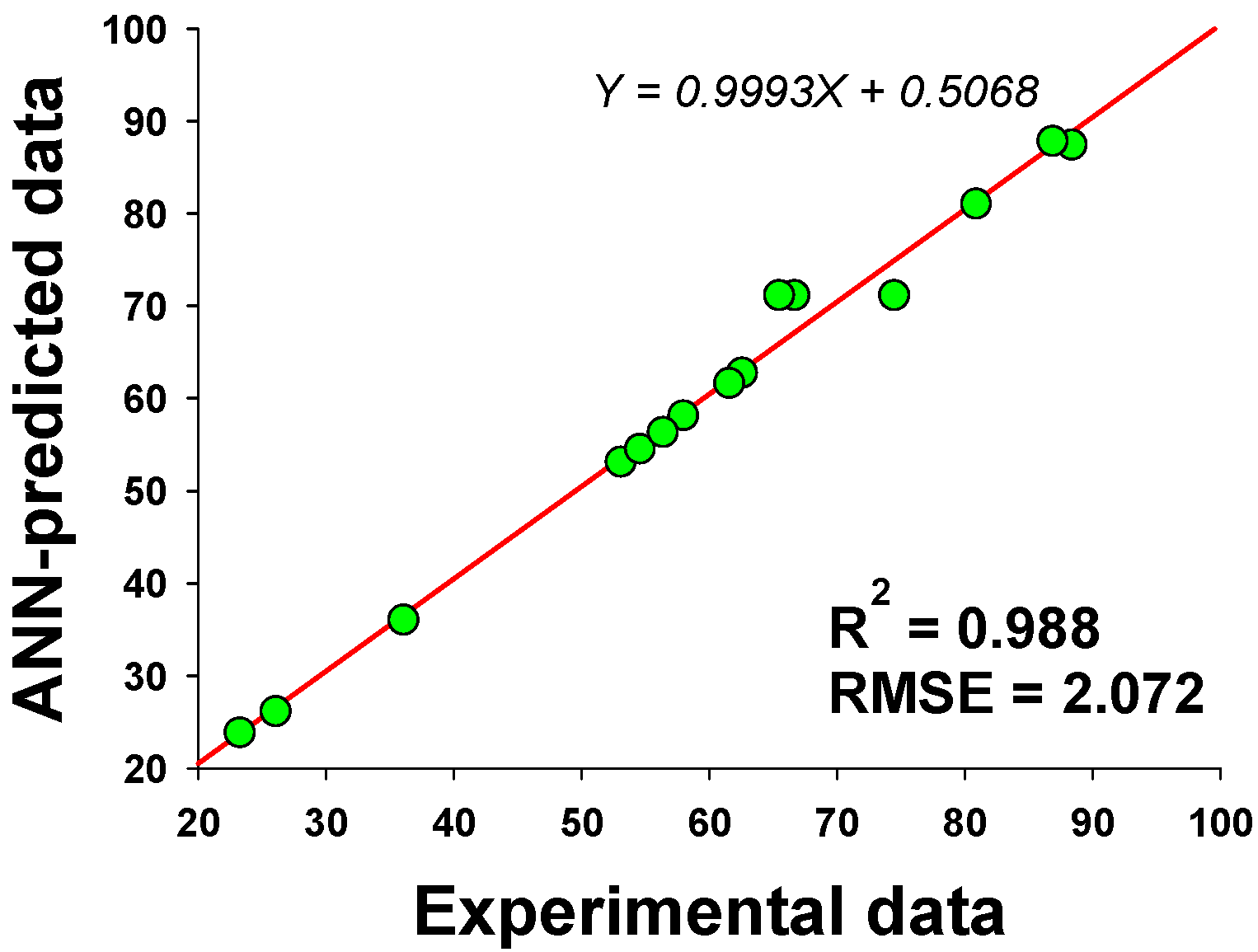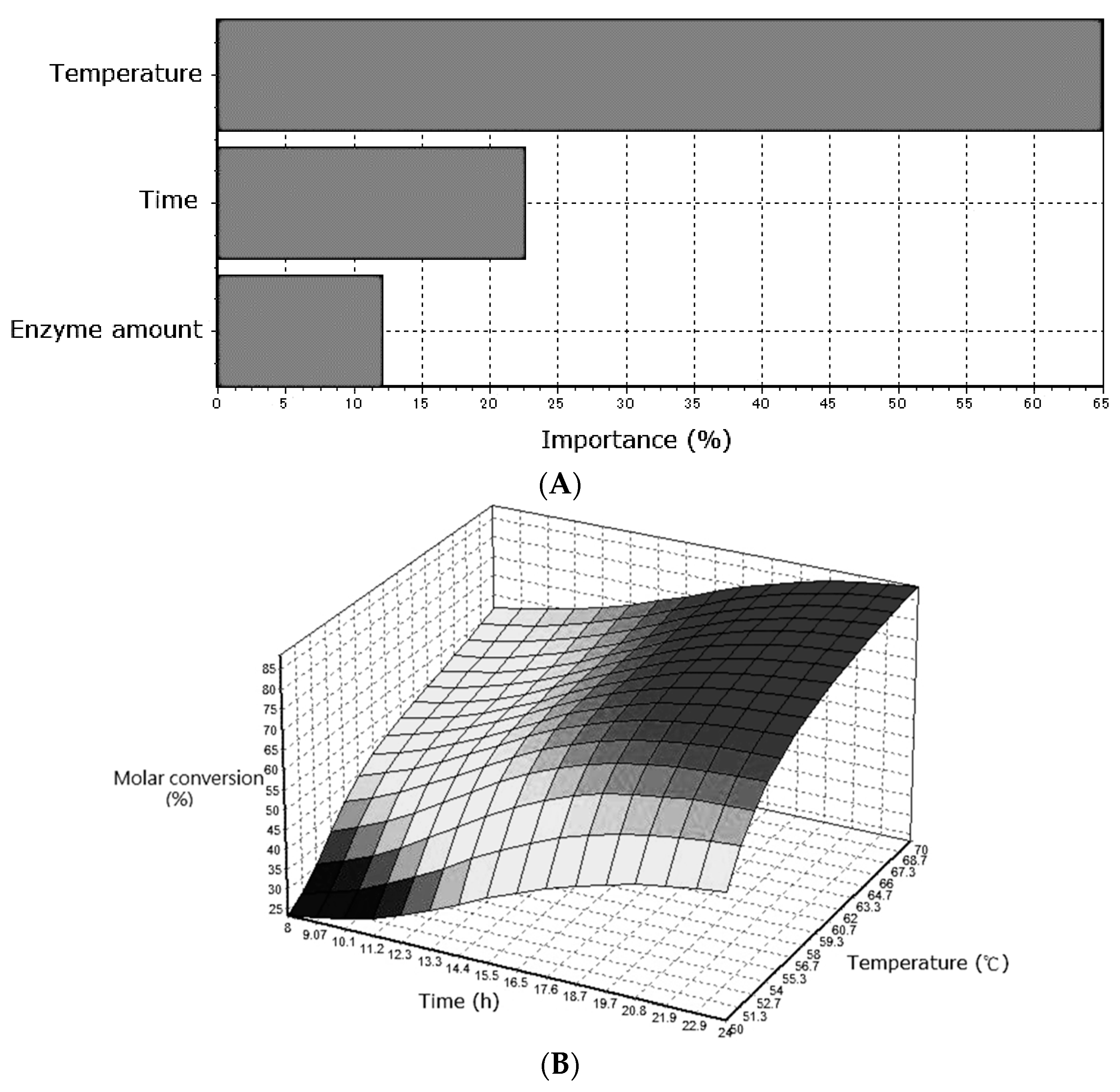Green Synthesis of Ultraviolet Absorber 2-Ethylhexyl Salicylate: Experimental Design and Artificial Neural Network Modeling
Abstract
:1. Introduction
2. Results and Discussion
2.1. Preliminary Test
2.2. Artificial Neural Network
2.3. Enzyme Reusability
3. Materials and Methods
3.1. Materials
3.2. Synthesis of 2-Ethylhexyl Salicylate
3.3. Box–Behnken Design
3.4. Process Optimuzation by Artificial Neural Network (ANN)
4. Conclusions
Acknowledgments
Author Contributions
Conflicts of Interest
References
- Singh, M.; Beck, M. Octyl salicylate: A new contact sensitivity. Contact Dermat. 2007, 56, 48. [Google Scholar] [CrossRef] [PubMed]
- Sugiyama, K.; Tsuchiya, T.; Kikuchi, A.; Yagi, M. Optical and electron paramagnetic resonance studies of the excited triplet states of UV-B absorbers: 2-ethylhexyl salicylate and homomenthyl salicylate. Photochem. Photobiol. Sci. 2015, 14, 1651–1659. [Google Scholar] [CrossRef] [PubMed]
- Hino, M.; Arata, K. Synthesis of esters from terephthalic and phthalic acids with n-octyl and 2-ethylhexyl alcohol, acrylic acid with ethanol and salicylic acid with metha. Appl. Catal. 1985, 18, 401–404. [Google Scholar] [CrossRef]
- Villa, C.; Baldassari, S.; Gambaro, R.; Mariani, E.; Loupy, A. Eco-friendly methodologies for the synthesis of some aromatic esters, well-known cosmetic ingredients. Int. J. Cosmet. Sci. 2005, 27, 11–16. [Google Scholar] [CrossRef] [PubMed]
- Jacobsen, E.E.; el-Behairy, M.F.; Skattebøl, L.; Anthonsen, T. Enantiopure dihalocyclopropyl alcohols and esters by lipase catalyzed kinetic resolution. J. Biotechnol. 2013, 168, 284–288. [Google Scholar] [CrossRef] [PubMed]
- Ansorge-Schumacher, M.B.; Thum, O. Immobilised lipases in the cosmetics industry. Chem. Soc. Rev. 2013, 42, 6475–6490. [Google Scholar] [CrossRef] [PubMed]
- Bezborodov, A.M.; Zagustina, N.A. Enzymatic biocatalysis in chemical synthesis of pharmaceuticals (Review). Appl. Biochem. Microbiol. 2016, 52, 237–249. [Google Scholar] [CrossRef]
- Daniel, M.S.; María, L.I.; Vicente, G.F. Hydrolases in Organic Chemistry. Recent Achievements in the Synthesis of Pharmaceuticals. Curr. Organ. Chem. 2016, 20, 1186–1230. [Google Scholar]
- Luna, C.; Verdugo, C.; Sancho, E.; Luna, D.; Calero, J.; Posadillo, A.; Bautista, F.; Romero, A. Biocatalytic behaviour of immobilized Rhizopus oryzae lipase in the 1,3-selective ethanolysis of sunflower oil to obtain a biofuel similar to biodiesel. Molecules 2014, 19, 11419–11439. [Google Scholar] [CrossRef] [PubMed]
- Kuo, C.H.; Hsiao, F.W.; Chen, J.H.; Hsieh, C.W.; Liu, Y.C.; Shieh, C.J. Kinetic aspects of ultrasound-accelerated lipase catalyzed acetylation and optimal synthesis of 4′-acetoxyresveratrol. Ultrason. Sonochem. 2013, 20, 546–552. [Google Scholar] [CrossRef] [PubMed]
- Yan, Y.; Bornscheuer, U.T.; Stadler, G.; Lutz-Wahl, S.; Otto, R.T.; Reuss, M.; Schmid, R.D. Regioselective lipase-catalyzed synthesis of glucose ester on a preparative scale. Eur. J. Lipid Sci. Technol. 2001, 103, 583–587. [Google Scholar] [CrossRef]
- Reyes-Duarte, D.; López-Cortés, N.; Ferrer, M.; Plou, F.J.; Ballesteros, A. Parameters affecting productivity in the lipase-catalysed synthesis of sucrose palmitate. Biocatal. Biotransform. 2005, 23, 19–27. [Google Scholar] [CrossRef] [Green Version]
- Ferrer, M.; Soliveri, J.; Plou, F.J.; López-Cortés, N.; Reyes-Duarte, D.; Christensen, M.; Copa-Patiño, J.L.; Ballesteros, A. Synthesis of sugar esters in solvent mixtures by lipases from Thermomyces lanuginosus and Candida antarctica B, and their antimicrobial properties. Enzyme Microb. Technol. 2005, 36, 391–398. [Google Scholar] [CrossRef]
- Maugard, T.; Tudella, J.; Legoy, M.D. Study of vitamin ester synthesis by lipase-catalyzed transesterification in organic media. Biotechnol. Prog. 2000, 16, 358–362. [Google Scholar] [CrossRef] [PubMed]
- Torres, P.; Reyes-Duarte, D.; López-Cortés, N.; Ferrer, M.; Ballesteros, A.; Plou, F.J. Acetylation of vitamin E by Candida antarctica lipase B immobilized on different carriers. Process Biochem. 2008, 43, 145–153. [Google Scholar] [CrossRef]
- Kuo, C.H.; Chiang, S.H.; Ju, H.Y.; Chen, Y.M.; Liao, M.Y.; Liu, Y.C.; Shieh, C.J. Enzymatic synthesis of rose aromatic ester (2-phenylethyl acetate) by lipase. J. Sci. Food Agric. 2012, 92, 2141–2147. [Google Scholar] [CrossRef] [PubMed]
- Haraldsson, G.G.; Gudmundsson, B.O.; Almarsson, O. The synthesis of homogeneous triglycerides of eicosapentaenoic acid and docosahexaenoic acid by lipase. Tetrahedron 1995, 51, 941–952. [Google Scholar] [CrossRef]
- Sugai, T.; Takizawa, M.; Bakke, M.; Ohtsuka, Y.; Ohta, H. Efficient lipase-catalyzed preparation of long-chain fatty acid esters of bile acids: Biological activity and synthetic application of the products. Biosci. Biotechnol. Biochem. 1996, 60, 2059–2063. [Google Scholar] [CrossRef] [PubMed]
- Paravidino, M.; Hanefeld, U. Enzymatic acylation: Assessing the greenness of different acyl donors. Green Chem. 2011, 13, 2651–2657. [Google Scholar] [CrossRef]
- Sheldon, R.A. The E factor 25 years on: The rise of green chemistry and sustainability. Green Chem. 2017, 19, 18–43. [Google Scholar] [CrossRef]
- Ye, R.; Hayes, D.; Burton, R.; Liu, A.; Harte, F.; Wang, Y. Solvent-free lipase-catalyzed synthesis of technical-grade sugar esters and evaluation of their physicochemical and bioactive properties. Catalysts 2016, 6, 78. [Google Scholar] [CrossRef]
- Huang, K.C.; Li, Y.; Kuo, C.H.; Twu, Y.K.; Shieh, C.J. Highly efficient synthesis of an emerging lipophilic antioxidant: 2-ethylhexyl ferulate. Molecules 2016, 21, 478. [Google Scholar] [CrossRef] [PubMed]
- Lo, C.F.; Yu, C.Y.; Kuan, I.C.; Lee, S.L. Optimization of lipase production by Burkholderia sp. using response surface methodology. Int. J. Mol. Sci. 2012, 13, 14889–14897. [Google Scholar] [CrossRef] [PubMed]
- Yu, C.Y.; Huang, L.Y.; Kuan, I.C.; Lee, S.L. Optimized production of biodiesel from waste cooking oil by lipase immobilized on magnetic nanoparticles. Int. J. Mol. Sci. 2013, 14, 24074–24086. [Google Scholar] [CrossRef] [PubMed]
- Jahirul, M.; Brown, R.; Senadeera, W.; O’Hara, I.; Ristovski, Z. The use of artificial neural networks for identifying sustainable biodiesel feedstocks. Energies 2013, 6, 3764–3806. [Google Scholar] [CrossRef]
- Li, H.; Zhang, Z.; Liu, Z. Application of artificial neural networks for catalysis: A review. Catalysts 2017, 7, 306. [Google Scholar] [CrossRef]
- Nelofer, R.; Ramanan, R.N.; Rahman, R.N.Z.R.A.; Basri, M.; Ariff, A.B. Comparison of the estimation capabilities of response surface methodology and artificial neural network for the optimization of recombinant lipase production by E. coli BL21. J. Ind. Microbiol. Biotechnol. 2012, 39, 243–254. [Google Scholar] [CrossRef] [PubMed]
- Orellana-Coca, C.; Camocho, S.; Adlercreutz, D.; Mattiasson, B.; Hatti-Kaul, R. Chemo-enzymatic epoxidation of linoleic acid: Parameters influencing the reaction. Eur. J. Lipid Sci. Technol. 2005, 107, 864–870. [Google Scholar] [CrossRef]
- Kuo, C.H.; Liu, Y.C.; Chang, C.M.J.; Chen, J.H.; Chang, C.; Shieh, C.J. Optimum conditions for lipase immobilization on chitosan-coated Fe3O4 nanoparticles. Carbohydr. Polym. 2012, 87, 2538–2545. [Google Scholar] [CrossRef]
- Huang, S.M.; Kuo, C.H.; Chen, C.A.; Liu, Y.C.; Shieh, C.J. RSM and ANN modeling-based optimization approach for the development of ultrasound-assisted liposome encapsulation of piceid. Ultrason. Sonochem. 2017, 36, 112–122. [Google Scholar] [CrossRef] [PubMed]
- Maran, J.P.; Priya, B. Comparison of response surface methodology and artificial neural network approach towards efficient ultrasound-assisted biodiesel production from muskmelon oil. Ultrason. Sonochem. 2015, 23, 192–200. [Google Scholar] [CrossRef] [PubMed]
- Basri, M.; Rahman, R.N.Z.R.A.; Ebrahimpour, A.; Salleh, A.B.; Gunawan, E.R.; Rahman, M.B.A. Comparison of estimation capabilities of response surface methodology (RSM) with artificial neural network (ANN) in lipase-catalyzed synthesis of palm-based wax ester. BMC Biotechnol. 2007, 7, 53. [Google Scholar] [CrossRef] [PubMed]
- Kumar, V.; Jahan, F.; Kameswaran, K.; Mahajan, R.V.; Saxena, R.K. Eco-friendly methodology for efficient synthesis and scale-up of 2-ethylhexyl-p-methoxycinnamate using Rhizopusoryzae lipase and its biological evaluation. J. Ind. Microbiol. Biotechnol. 2014, 41, 907–912. [Google Scholar] [CrossRef] [PubMed]
- Selmi, B.; Thomas, D. Immobilized lipase-catalyzed ethanolysis of sunflower oil in a solvent-free medium. J. Am. Oil Chem. Soc. 1998, 75, 691–695. [Google Scholar] [CrossRef]
- Chen, H.C.; Ju, H.Y.; Twu, Y.K.; Chen, J.H.; Chang, C.M.; Liu, Y.C.; Chang, C.; Shieh, C.J. Optimized enzymatic synthesis of caffeic acid phenethyl ester by RSM. New Biotechnol. 2010, 27, 89–93. [Google Scholar] [CrossRef] [PubMed]
- Kuo, C.H.; Liu, T.A.; Chen, J.H.; Chang, C.M.J.; Shieh, C.J. Response surface methodology and artificial neural network optimized synthesis of enzymatic 2-phenylethyl acetate in a solvent-free system. Biocatal. Agric. Biotechnol. 2014, 3, 1–6. [Google Scholar] [CrossRef]








| Temperature (°C) | Time (h) | Enzyme Amount (PLU) | Molar Conversion (%) a |
|---|---|---|---|
| 50 | 16 | 500 | 26.1 ± 3.2 |
| 60 | 16 | 750 | 66.7 ± 4.7 |
| 60 | 24 | 500 | 62.6 ± 2.8 |
| 70 | 24 | 750 | 88.4 ± 1.5 |
| 60 | 16 | 750 | 65.5 ± 6.4 |
| 50 | 16 | 1000 | 53.1 ± 3.1 |
| 70 | 16 | 500 | 58.0 ± 2.8 |
| 50 | 8 | 750 | 23.3 ± 4.3 |
| 60 | 16 | 750 | 74.5 ± 1.5 |
| 70 | 16 | 1000 | 80.9 ± 4.2 |
| 70 | 8 | 750 | 61.6 ± 2.7 |
| 60 | 24 | 1000 | 86.9 ± 1.9 |
| 50 | 24 | 750 | 54.6 ± 0.8 |
| 60 | 8 | 500 | 36.1 ± 2.6 |
| 60 | 8 | 1000 | 56.4 ± 3.5 |
| Time (h) | Temperature (°C) | Enzyme Amount (PLU) | Relative Conversion (%) | |
|---|---|---|---|---|
| Experimental | ANN-Predicted | |||
| 10 | 55 | 600 | 32.0 | 32.7 |
| 12 | 55 | 700 | 42.1 | 42.2 |
| 14 | 55 | 800 | 57.9 | 54.1 |
| 20 | 65 | 900 | 81.8 | 85.1 |
| 23.1 | 66.5 | 881 | 88.2 | 87.0 |
© 2017 by the authors. Licensee MDPI, Basel, Switzerland. This article is an open access article distributed under the terms and conditions of the Creative Commons Attribution (CC BY) license (http://creativecommons.org/licenses/by/4.0/).
Share and Cite
Huang, S.-M.; Hung, T.-H.; Liu, Y.-C.; Kuo, C.-H.; Shieh, C.-J. Green Synthesis of Ultraviolet Absorber 2-Ethylhexyl Salicylate: Experimental Design and Artificial Neural Network Modeling. Catalysts 2017, 7, 342. https://doi.org/10.3390/catal7110342
Huang S-M, Hung T-H, Liu Y-C, Kuo C-H, Shieh C-J. Green Synthesis of Ultraviolet Absorber 2-Ethylhexyl Salicylate: Experimental Design and Artificial Neural Network Modeling. Catalysts. 2017; 7(11):342. https://doi.org/10.3390/catal7110342
Chicago/Turabian StyleHuang, Shang-Ming, Tzu-Hsiang Hung, Yung-Chuan Liu, Chia-Hung Kuo, and Chwen-Jen Shieh. 2017. "Green Synthesis of Ultraviolet Absorber 2-Ethylhexyl Salicylate: Experimental Design and Artificial Neural Network Modeling" Catalysts 7, no. 11: 342. https://doi.org/10.3390/catal7110342







